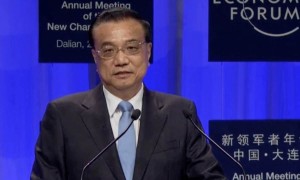China is moving to replace decades-old agricultural subsidies with a more flexible pricing mechanism, as domestic harvests in the world's largest grain importer are expected to see their 11th consecutive year of growth.
Experts say the change will not endanger food security nor result in steep price drops in major agricultural products.
Decisions to scrap the minimum purchasing price for rice, the temporary storage policy for soy and cotton and other agricultural subsidy policies were made on Wednesday at a State Council executive meeting led by Premier Li Keqiang.
Under the new policy, the government will set up a target price for each kind of major agricultural product. Farmers will receive subsidies from the government when the market price is below the target, while low-income groups will receive subsidies when the market price sours.
The reform, which aims to restore a market-oriented pricing mechanism, as domestic grain prices are usually above the global price, will be conducted first from selected areas and particular types of agricultural products.
According to a statement released after the meeting, soy and cotton will be first in line to test the concept before the policy is applied to other major agricultural products, such as wheat, rice and corn.
China gradually has set up various subsidy policies since 2004 to shore up grain prices and protect the motivation for farming.
These subsidies, along with the removal of the agriculture tax, have somehow contributed to the country's decadelong growth of grain output. But analysts argued that the minimum purchasing price, which is much higher than the market, has resulted in a considerable price discrepancy between the domestic and global markets.
This year, the government increased its mandated minimum purchasing price for wheat by 70 percent to ensure food security.
As Wednesday's meeting pledged more market involvement in the pricing of agricultural products, the central government's responsibility for price controls will be mainly seen with "grains, cotton, oil plants and sugar plants", the statement said.
"Under the premise of self-sufficiency and food security, policies on imports and exports and the storage of grains will be adjusted to prevent steep price fluctuations," it said.
"The harvest of the summer grain crop this year is settled,... but the shortage of storage rooms has become a problem," the statement said, pledging that the country will build another 100 billion metric tons of storage capacity by 2015.
Gao Fang, vice-president of the China Cotton Association, said linking subsidies to target prices can protect the interests of farmers while nurturing a market-oriented pricing mechanism. She rebutted the allegation that the change will dent the motivation of farmers.
The Ministry of Agriculture said it expects higher output of winter wheat and early-season rice this year, which will bolster food self-sufficiency and ease worries about food security.
China's annual grain output in 2013 reached 601.9 million tons. China's grain output increased 134 million tons between 2000 and 2012, accounting for nearly one-third of the total increase of the global food harvest.
New polluting projects barred from regions
Coal-fired power plants and other highly polluting energy projects will not be allowed in major economic engine areas of coastal China under the country's plan to redistribute its industrial layout.
The State Council's executive meeting decided on Wednesday to prohibit any new high-pollution and high-consumption power projects in the Beijing-Tianjin-Hebei triangle as well as Yangtze River Delta and Pearl River Delta areas-three major economic regions in China.
The meeting required different areas to develop their own advantages on industries and make full use of their geographic positions, while vowing to fasten infrastructure construction and improve finance and taxation services in underdeveloped western China. New policies will be issued to attract labor-intensive industries to move from eastern China to the west.
One of the ongoing industrial redistribution pilots is the planned coordinated development of a Beijing-centered "economic circle", including Tianjin and Hebei province.
An industrial redistribution directory is being drafted to rearrange industries in the three areas, according to the Ministry of Industry and Information Technology, covering the triangle with more than 100 million population and a combined GDP of more than 6 trillion yuan ($960 billion).







